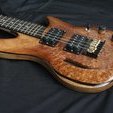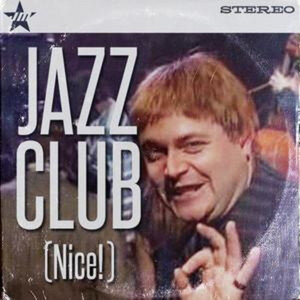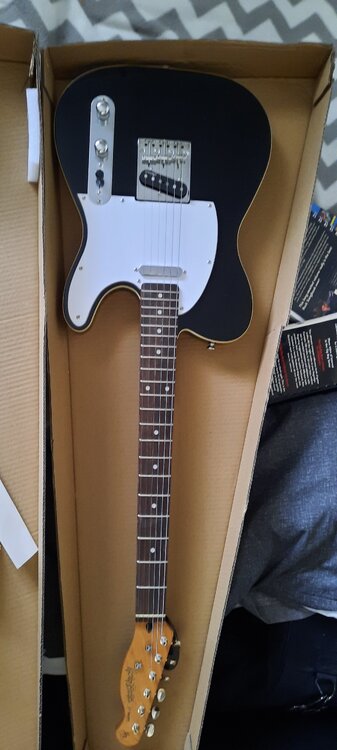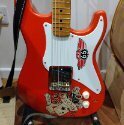Leaderboard
Popular Content
Showing content with the highest reputation on 14/07/23 in all areas
-
I do love the look of it. The slightly sharp fret ends are the only thing that annoy me, but you don't feel it if your finger is perpendicular to the neck. I'm torn between being a fret file and having a go at going it myself (I would tape of the neck and fretboard, obviously) and paying someone to do it. I think the caramel maple is just roast maple. The laurel really does look like rosewood. I don't buy into the whole tone wood debate, so I'm not worried about anything there. It has a tele sound, obviously. I'm going to have to compare it with the cheap TE-20 to see if there is much difference in the sound of the pickups. I'll probably change the strings. The website says they are d'Addario EXL 110 10-46s. I'm not fussed on the feel of them. I thought d'Addario strings had coloured ball ends, but these are just brass. I might go for Ernie Balls.1 point
-
1 point
-
That's a stunning piece of work, really lovely. Definitely look forward to hear the soundclips!1 point
-
Lovely! Interesting this version has a skunk stripe. I'd wondered if they were using the 62 delineation as a time-related thing. Some of the HB guitars seem to have a nod to the design era in the name (like the PB-50), others don't. The S types with the 62 in the name don't have a truss rod, which would have been the case with Fenders from, roughly, 59-71 (always there are outliers as Fender had a real habit of using up old stock and phasing in the changes gradually). The skunk stripe disappeared originally as it wasn't needed when the fingerboard became a separate piece - rosewood - after 1959. When they brought them back in 71 it's cause they'd simplified the manufacturing processes, and all necks had them irrespective of whether they were one piece or the board added separately. I've always liked that utilitarian approach with Fender designs. The skunk stripe looks beautifully finished. I like the binding too. Reminds me of Muddy Waters' Tele Custom, save in black rather than red - just needs a couple of Fender amp knobs on the pots! Intrigued by the caramelised maple. Is there any indication as to what that means anywhere with the packaging? I did previously assume it was another term for roasted maple, but I see HB are also separately referring to some of their guitars as having roasted maple necks. Wonder if it's a question of degree? Either way, it has a really lovely amber tone to it that I think gives them a real cosmetic boost. My old Fender is from that mid 90s period when the maple looked crazily anaemic - a few years of sun exposure helped a lot there. Interesting to see laurel as an alternative to rosewood here. Looks a dead ringer - I doubt anyone could really tell the difference by sound, though tbh I've always maintained that the notion you can hear differences between different woods on an F type dubious. An acoustic, sure, But an electric guitar? Through fuzz, drive, an amp...? Eh. Personally, I think the much bigger deal with the Tele sound is mounting the bridge pick-up in the steel bridge like that. It's a thing of sonic beauty. I spent years trying to replicate Hendrix's lead tones on Purple Haze with a Strat - only to discover that on the night he recorded those, he'd earlier smashed his Strat's headstock on the low ceiling in (I think) the 100 Club, and played that session on a borrowed Telecaster, restrung lefty... I like that they've kept a three saddle bridge, too - a defining feature of the telecaster type for me. At the other end, I'm really enjoying the HB headstocks. Just different enough than their original inspiration to stand proud as their own thing, but that also look really good too, seem balanced with the body shape and everything. I'll have to hold off for a while now on buying anything new (recently bought an MR Classic, my loyalty sale DC Jnr arrives Monday, and I should have a JA25th when they are back in stock early September), but I'll be really interested in your review on this and how it sings when it's plugged in. The T52 model is calling me like a siren...1 point
-
The downside is that you will end up wearing a black turtleneck and beret, and star smoking Gitanes.1 point
-
For anyone starting out on guitar, I will always recommend this (very inexpensive...) method, which put me on an excellent track from an early age. Don't be fooled by the title; it's useful stuff in all genres of playing. Here's an Amazon link; other sources are surely available... Mickey Baker's Complete Course in Jazz Guitar. Book 1 ... I've worn out quite a few copies, and am still using it over half a century later, and still coming across new things in there. For such a low price, what's there to lose..? Give it a go...1 point
-
Here's a couple of things that I quickly found on Yt for Carl.1 point
-
1 point
-
And...it's finished!!!! The 'last few jobs' always turn out to be a 'myriad of final jobs. Anyway, all sorted. I'm passing it across to Alex tomorrow - I will try and get him to do a bit of recording at one of their band practices but, in the meantime, you'll have to trust me when I say it sounds great . Although it is just a small wiring change and no hardware change, I've opted NOT to go for the P-rails standard wiring system which gives: Full series humbucker; parallel humbucker; P90; Rails. I've used that system in a number of my own gigging guitars and I found that: - the fact that both pickups are always in the same configuration for the four options is actually, ironically, quite limiting. I was always hankering for, such as, 'neck pickup full series humbuck for the depth, mixed with bridge pickup in split coil mode to add a bit of extra treble and dispel any muddiness' and similar - I also never, in practice, used the rails by themselves...not enough ooomph - and I never, in practice, used the humbuckers in parallel...not enough depth I talked that through with Alex and, for kickoff, we decided to have a standard split coil option for both pickups where the operating coil in each case was the P90. So he can go full series humbucker with 3 way options, P90 with 3 way options and one (either) pickup P90 and the other series humbucker. It's a 30 minute job to change the wiring to the 'P-rail standard' options if he wants to try that in the future. Anyway, here are some of the arty-farty finished pics: Thanks again for watching this develop and your kind remarks along the way1 point
-
I spent some time this morning with the guitar strung up and on a strap for me to 'fit' the neck profile to suit Alex's style of playing. Basically, he played, I then scraped material off the neck haunches and then he tried it again. This was repeated over an hour until it 'felt right' for him. We can do further tweaks once it's finished and he can play it with amp/etc but it's probably close enough for me to start the final sanding, which I started this afternoon. As folks who have watched other builds will know, I often use some Tru-oil slurry and wiped to act as a grain filler and also as a reveal coat... to spot dints and lumps or sanding marks that are difficult to see on dry sanded wood. The good thing is that it also lets bot Alex and me see how the final colours and grain are going to turn out to be. I think it's going to be quite nice:1 point
-
Well family stuff and domestic 'projects' largely clear and so I'm back to the build I'm not quite at the final furlong stage, but certainly getting closer to it. Next jobs were to finish the rough carving on the back and getting ready to sort the control chamber hatch. For the carve at the back, because it's curved, I am mainly using the larger of the two round-bottomed Ibex thumb planes and also the gooseneck card scraper: Don't let anyone tell you the Ibex planes are toys - they really are precision planes: Those curly shavings are rock maple and ebony! I used a bottom bearing rebate router bit to follow the chamber and mark the outer edge of the rebate - but the curve of the back makes it difficult to get an even depth of cut and so the rebate was cut to final depth using carpenters mallet and some sharp chisels. Done, ready to create the paper template and cut the hatch:1 point
-
I have done exactly this, as well as just purchased necks on eBay as they sometimes have tuners included. Got a great Squier Korean maple neck and an even greater Aria XL neck 9with sharkfin inlays) in this way. Don't have to worry about varnish then either.1 point
-
1 point
-
I might be thinking of Warmoth - here you start with a blank and then can add through their configurator the various routs and drill holes you want. Looks pricey, but a decent blank piece of alder that I would use starts off at anything from £90 to £150 here in UK. I think other suppliers do something similar and probably cheaper - I'll carry on looking Warmoth necks are great...but VERY expensive. However, there are a myriad of perfectly decent 'Fender standard pocket' necks available for less than (and some cases, much less than) £100 that an internet search will find (Gear4Music is a decent place to start).1 point



.thumb.jpg.2f0f241a63381e5644f287abacd76760.jpg)



